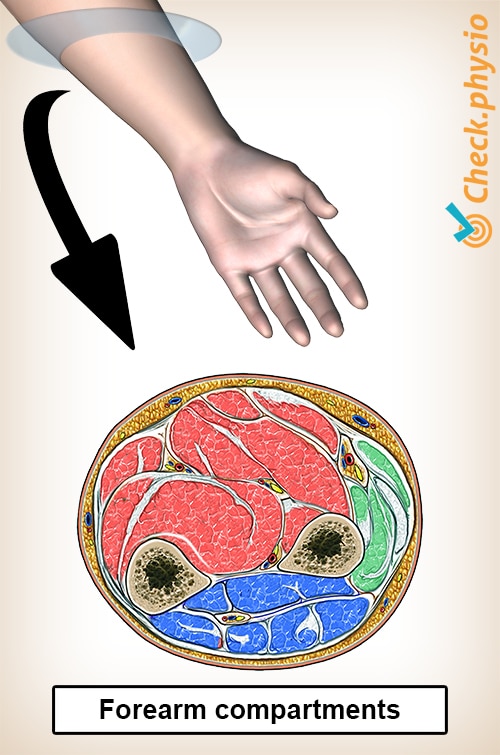Compartment syndrome of the forearm
Compartment syndrome
The forearm has 19 different muscles that are important for the function of the elbow, wrist and hand. These muscles are grouped, the so-called compartments. If muscles cannot recover properly after an activity, the pressure in the relevant compartment becomes too high and complex symptoms develop. This is referred to as compartment syndrome.

Two forms are distinguished: chronic and acute compartment syndrome.
Description of the condition
Compartments are groups of muscles, blood vessels and nerves that are surrounded by a connective tissue membrane (fascia). A fascia cannot stretch, so when it swells, pressure increases in that compartment. This can cause damage to the tissue in the compartment.
Also, the blood supply will reduce, which will decrease the oxygenation of the muscles. This reduces the recovery capacity of the tissue in the compartment and creates a vicious circle: because the muscles’ ability to recover is not as good, there is more strain which, in turn, causes swelling, etc.
Cause and origin
Chronic compartment syndrome of the forearm is a condition seen in sports activities that require a lot of static muscle strength. Static muscle strength is the tightening of muscles without any movement taking place. For the forearm, this is mainly pinching. This may include sports such as motocross, gymnastics, mountaineering and sport climbing. This is the sport-related cause. If many pinching movements are made in everyday life, for example trimming hedges, this condition can also occur.
As described, this is caused by increased pressure in an enclosed space. In acute compartment syndrome, this can occur as a result of swelling after a bone fracture. It can also occur with long-term plaster casts, because the forearm is not moved for a long time and the fluid cannot be drained properly, so that the pressure remains too high.
Signs & symptoms
Chronic compartment syndrome is mainly manifested as increasing, cramp-like pain. The feeling of cramps and/or pain is present, particularly when subjected to static strain. There may be loss of strength and tingling in the forearm and all the fingers. When the forearm is touched (palpated), it feels harder due to increased muscle tension. In chronic compartment syndrome, the symptoms disappear a few minutes (0-15 min) after exertion.
If the symptoms of tension and cramping persist, this is referred to as acute compartment syndrome. The symptoms of acute compartment syndrome are:
- Swollen forearm
- Visibly increased muscle tension
- Pink or red skin on the forearm
- Tingling
- Loss of sensation
- Loss of strength
- Increased pressure within one or more compartments (on pressure measurement)
Diagnosis
The diagnosis of compartment syndrome is made primarily on the basis of the patient's story, specific questions and a physical examination. In the event of suspected compartment syndrome, a pressure measurement can be carried out to determine the pressure in the compartment in question. This is particularly useful in the event of acute compartment syndrome.
In the event of suspected acute compartment syndrome, rapid action is required to prevent necrosis. The pressure is measured to determine the level of the pressure and any treatment options.
In the event of chronic compartment syndrome, this pressure measurement is less useful because the symptoms disappear within a few minutes.
Treatment
The treatment of chronic compartment syndrome consists mainly of rest, possibly anti-inflammatories, and physiotherapy for guidance and help in reducing the pressure.
In the event of acute compartment syndrome, the treatment depends on the measured pressure, but it will often require surgical intervention to normalise the compartment pressure. This involves cutting the connective tissue membrane, which directly reduces the pressure within the compartment. The subsequent rehabilitation is aimed at the recovery of any damaged tissue and improving hand/arm function. If little tissue is damaged, resumption of sports activities is possible after 4-6 weeks.
If signs of necrosis are present, surgical intervention within 6 hours is important to minimise nerve damage. These intense and rapid phenomena occur mainly after a fracture or major trauma (accident) to the forearm. Fortunately, this acute form is a rarity.
Exercises
You can check your symptoms using the online physiotherapy check or make an appointment with a physiotherapy practice in your area.
References
Bahr, R. (2012). The IOC Manual of sports injuries. International Olympic committee, Wiley Blackwell.
Brukner, P. & Khan, K. (2016). Clinical sports medicine (Nederlandse bewerking). 4th edition. Michel van Troost. PreVision, Eindhoven.
Heemskerk, V.H., Hulsewé, K.W.E., Stroeken, H.J.G. & Hoofwijk, A.G.M. (2004). Het acute compartimentsyndroom van de arm. Ned Tijdschr Geneeskd 2004 6 november;148(45).


